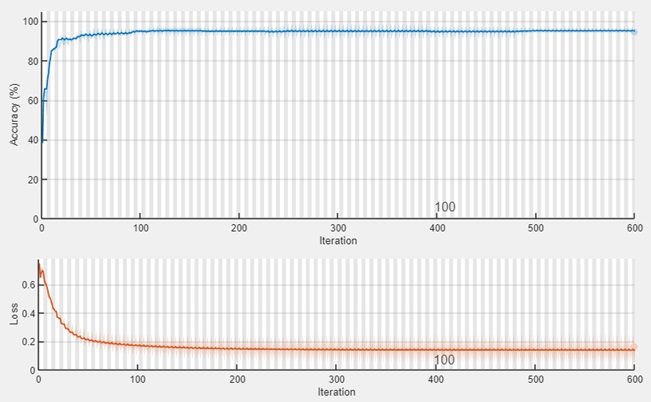Improving Diabetic Patients Monitoring System Using (NCA-CNN) Algorithm based on loT
DOI:
https://doi.org/10.51173/jt.v6i2.2316Keywords:
Internet of Things, Diabetes, Deep Learning, Smart Health System, CNNAbstract
The Internet of Things (IoT) and Artificial Intelligence (AI), particularly Machine Learning (ML), have both seen significant advancements in recent years, which has resulted in significant leaps forward in the development of health monitoring systems. Patients may now be prevented, diagnosed, and monitored remotely and at home, eliminating the need to go to health and treatment centers or spend a significant amount of money doing so. This is made possible by advancements in technology. Deep learning has been the primary focus of this research as it relates to the development of a remote health monitoring system for the diagnosis of diabetes. In the system that has been suggested, improvements have been made to both the precision of the detection and the swiftness of the data processing. The Neighbourhood Component Analysis-Convolutional Neural Network (NCA-CNN) approach that we have presented involves two stages: the first stage involves picking the most important features from all of the data, and the second stage involves categorizing the chosen features. The NCA algorithm is a mathematical method that rates the characteristics based on the results of an analysis of the data and picks the most significant aspects. After that, the most salient characteristics are categorized by a deep convolutional neural network, and an accurate diagnosis of the condition is accomplished. According to the findings that were collected, the accuracy of the approach that was suggested is 97.12%.
Downloads
References
Al-Kahtani MS, Khan F, Taekeun W. "Application of Internet of things and sensors in healthcare". Sensors, vol. 22, no. 15, pp.5738, 2022. https://doi.org/10.3390/s22155738.
Yuehong YIN, Y. Z, "The Internet of things in healthcare: An overview". Journal of Industrial Information Integration, vol. 1, pp. 3-13, 2016. https://doi.org/10.1016/j.jii.2016.03.004.
Dhillon PK, Kalra S. “Secure multi‐factor remote user authentication scheme for Internet of Things environments”. International Journal of Communication Systems, vol. 10, issue 30, pp.16, 2017. https://doi.org/10.1002/dac.3323.
Rghioui A, Lloret J, Parra L, Sendra S, Oumnad A. “Glucose data classification for diabetic patient monitoring”. Applied Sciences, vol. 9, no. 20, pp. :4459, 2019. https://doi.org/10.3390/app9204459.
Mian Z, Hermayer KL, Jenkins A. "Continuous glucose monitoring: a review of an innovation in diabetes management". The American Journal of the Medical Sciences, vol. 358, no. 5, pp. 332-9, 2019. https://doi.org/10.1016/j.amjms.2019.07.003.
Rghioui A, Lloret J, Harane M, Oumnad A. "A smart glucose monitoring system for the diabetic patient". Electronics, vol. 9, no. 4, pp. 678, 2020. https://doi.org/10.3390/electronics9040678.
Jayasri NP, Aruna R. “Big data analytics in health care by data mining and classification techniques”. ICT Express, vol. 8, no. 2, pp.250-7, 2022. https://doi.org/10.1016/j.icte.2021.07.001.
Ahmed HB, Serener A. “Effects of external factors in CGM sensor glucose concentration prediction”. Procedia Computer Scienc, vol. 102, pp. 623-9, 2016. https://doi.org/10.1016/j.procs.2016.09.452.
Raics M, Balogh ÁK, Kishor C, Timári I, Medrano FJ, Romero A, Go RM, Blanchard H, Szilágyi L, E. Kövér K, Fehér K. Investigation of the molecular details of the interactions of selenoglycosides and human galectin-3. International Journal of Molecular Science, vol. 23, no. 5, pp. 2494, 2022. https://doi.org/10.3390/ijms23052494.
Ratra R, Gulia P, Gill NS. “Performance Analysis of Classification Techniques in Data Mining using WEKA”. In Proceedings of the International Conference on Innovative Computing & Communication (ICICC), 2021 Jul 3. http://dx.doi.org/10.2139/ssrn.3879610.
Al-Hameli BA, Alsewari AA, Alsarem M. Prediction of diabetes using hidden Naïve Bayes: a comparative study. InAdvances on Smart and Soft Computing: Proceedings of ICACIn, pp. 223-233, 2021. Springer Singapore. https://doi.org/10.1007/978-981-15-6048-4_20.
Krishna B V, AP B, HL G, Ravi V, Almeshari M, Alzamil Y. A “Novel Application of K-means Cluster Prediction Model for Diabetes Early Identification using Dimensionality Reduction Techniques”. The Open Bioinformatics Journal, vol. 16, no. 1, 2023. DOI: 10.2174/18750362-v16-230825-2023-18.
Singh A, Dhillon A, Kumar N, Hossain MS, Muhammad G, Kumar M. eDiaPredict "An ensemble-based framework for diabetes prediction. ACM Transactions on Multimedia Computing Communications and Applications", vol. 17, no 2s, pp. 1-26, 2021. https://doi.org/10.1145/3415155.
Butt UM, Letchmunan S, Ali M, Hassan FH, Baqir A, Sherazi HH. "Machine learning based diabetes classification and prediction for healthcare applications". Journal of Healthcare Engineering, 2021. https://doi.org/10.1155/2021/9930985.
Abdollahi J, Nouri-Moghaddam B. “Hybrid stacked ensemble combined with genetic algorithms for diabetes prediction”. Iran Journal of Computer Science, vol. 5, no. 3, pp. 205-20, 2022. https://doi.org/10.1007/s42044-022-00100-1.
Oniani S, Marques G, Barnovi S, Pires IM, Bhoi AK. "Artificial intelligence for the internet of things and enhanced medical systems. Bio-inspired neurocomputing", pp. 43-59, 2022. https://doi.org/10.1007/978-981-15-5495-7_3.
Sivakumar NR, Karim FK. "An IoT-based big data framework using equidistant heuristic and duplex deep neural network for diabetic disease prediction". Journal of Ambient Intelligence and Humanized Computing, pp.1-11, 2021, https://doi.org/10.1007/s12652-021-03014-1.
Official website of pima Indians diabetes database, Kaggle, available at https://www.kaggle.com/uciml/pima-indians-diabetes-database, accessed 5-2-2024.
Goldberger J, Hinton GE, Roweis S, Salakhutdinov RR. “Neighbourhood components analysis. Advances in neural information processing systems”, p. 17, 2004.
Acharya UR, Oh SL, Hagiwara Y, Tan JH, “Adam M, Gertych A, San Tan R. A deep convolutional neural network model to classify heartbeats”. Computers in biology and medicine, vol. 89, pp. 389-96, 2017. https://doi.org/10.1016/j.compbiomed.2017.08.022.
Rejeb A, Rejeb K, Treiblmaier H, Appolloni A, Alghamdi S, Alhasawi Y, “Iranmanesh M. The Internet of Things (IoT) in healthcare: Taking stock and moving forward”. Internet of Things, p. 100721, 2023. https://doi.org/10.1016/j.iot.2023.100721.
Rghioui A, Naja A, Mauri JL, Oumnad A. “An IoT based diabetic patient monitoring system using machine learning and node MCU”. In Journal of Physics: Conference Series, vol. 1743, no. 1, p. 012035, 2021. IOP Publishing. DOI 10.1088/1742-6596/1743/1/012035.

Downloads
Published
How to Cite
Issue
Section
License
Copyright (c) 2024 Ayas Talib Mohammad, Jaber Parchami

This work is licensed under a Creative Commons Attribution 4.0 International License.
















